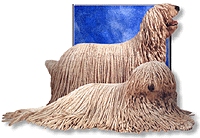Breed: Komondors
Temperament: Protective, can be aggressive
Lifespan: 10-12 years
Maintenance: Medium to high
Recommended for: Devotees
Appearance: Of all the world’s dog breeds the Komondor must be the most visually spectacular. A large, muscular breed of dog, the distinctive white, corded coat can reach the ground by the time it’s five to six years old.
Komondors reach 80cm (32″) for males, less for bitches, and weigh about 40kg (88lb). A mature coat may add a few kilos. The cords cover the entire body and head, and are parted to the skin, which should be grey. Eyes should be dark and the nose black.
The cords are made of matted hair. The baby coat is white, soft and fluffy then between 12-24 months the coat will begin to matt. The cords are not plaited or rolled by humans but may need untangling as they lengthen.
Temperament: Komondors are said to be protective and assertive, and will think for themselves. This also means they are not the breed for everyone and are probably best-suited to experienced dog owners. Longtime owners say their dogs are quite devoted and will monitor their every move.
Grooming: Despite their appearance, owners maintain Komondors are a low-to-medium maintenance breed, as the dogs don’t need brushing or blow drying, and unless they are being exhibited, are not bathed frequently as this can weaken the coat. When bathed, however, it can take 24-48 hours for a Komondor in full coat to dry. If fleas are detected, bathing in a commercial preparation is recommended. Vigilance is vital in tick danger areas.
Uses: Komondors are primarily a companion animal in Australia, although owners say they retain a strong guarding instinct.
Training: As with all large breeds, basic obedience training is strongly recommended. Pups need early socialisation and should bond closely with their human family. A few canine authorities from overseas claim the Komondor is one of the world’s best guard dogs.
Breeding: In Australia there is a small genetic pool, enthusiasts are looking to import more Komondors from overseas to increase breeding stock.
Health:
Hip dysplasia, a degenerative disease, has been found in dogs overseas but none locally. Breeders are monitoring the situation; Socialisation is important in large breeds such as this; The coat must be checked regularly for fleas, ticks and grass seeds, and treated accordingly.
Popularity: There are only 13 Komondors in Australia, and only a few thousand worldwide.
History: Developed to guard flocks of sheep and goats in its native country, Hungary, the distinctive corded coat acted as armour against attack by wolves, which should only get a mouthful of matted hair.
National contacts
To find up-to-date contacts for breeders, contact the following organisations.
Dogs NSW
http://www.dogsnsw.org.au/breeders-directory
Email: [email protected]
Phone: 1300 728 022 (NSW only) or (02) 9834 3022
Fax: (02) 9834 3872
Dogs Victoria
http://www.vca.org.au
Email: [email protected]
Phone: (03) 9788 2500
Fax: (03) 9788 2599
Dogs ACT
http://www.actca.asn.au
Email: [email protected]
Phone: (02) 6241 4404 – Fax: (02) 6241 1129.
Dogs West
http://www.cawa.asn.au
Email: [email protected]
Phone: (08) 9455 1188
Fax: (08) 9455 1190
Dogs SA
http://dogssa.com.au
Phone: (08) 8349 4797
Canine Control Council of Queensland
http://www.cccq.org.au
Email: [email protected]
Phone: (07) 3252 2661
Fax: (07) 3252 3864
Tasmanian Canine Association
http://www.tasdogs.com
Email: [email protected]
Phone: (03) 6272 9443
Fax: (03) 6273 0844
Dogs NT
http://www.territorydogworld.com
Email: [email protected]
Phone: (08) 8984 3570
Fax: (08) 8984 3409



